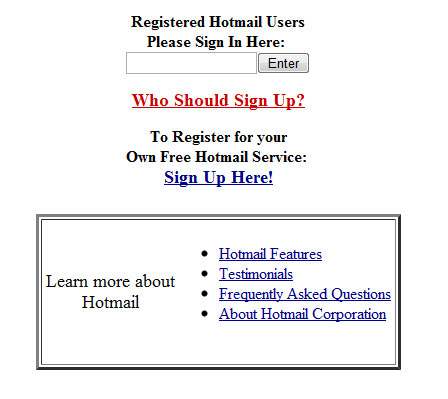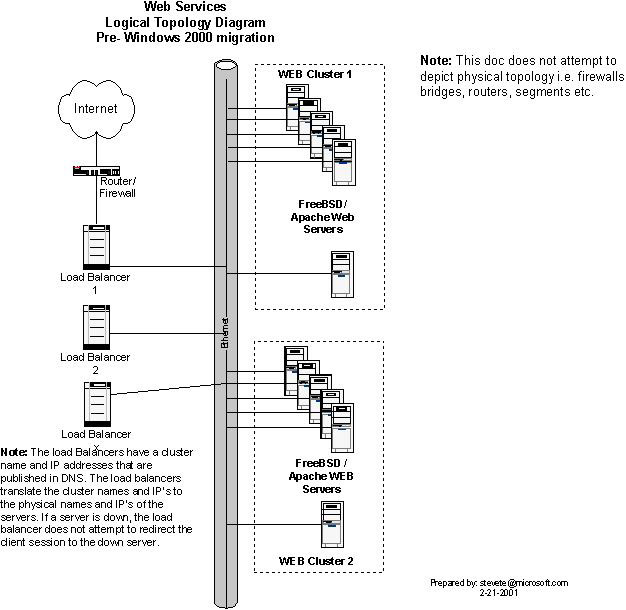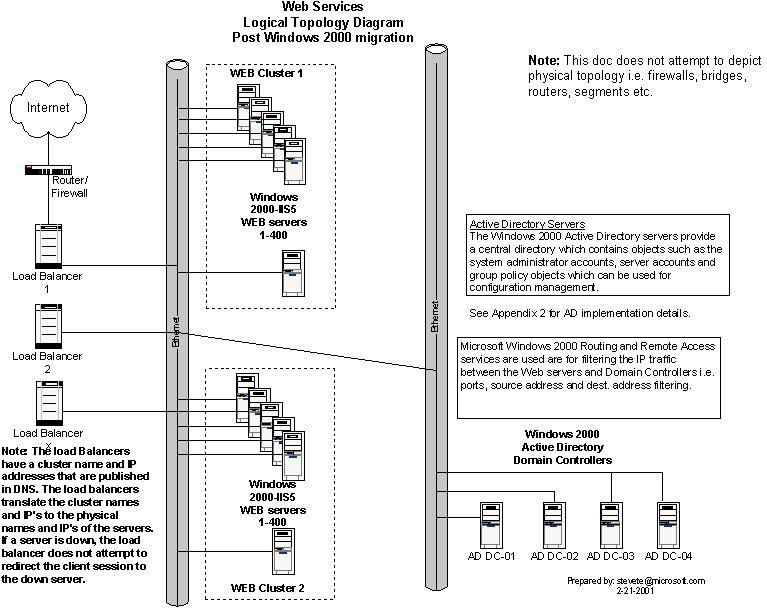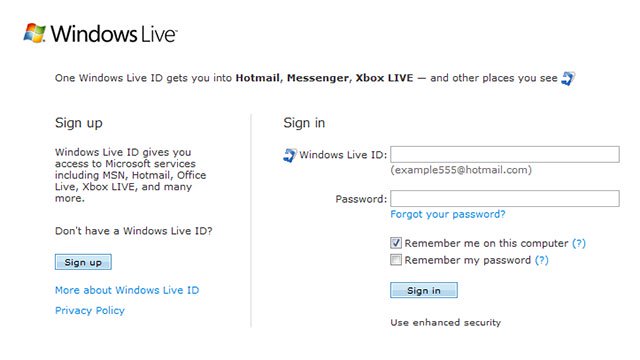How has Hotmail forever changed Microsoft and the entire email world?
Around this time 20 years ago, on December 29, 1997, Bill Gates gave Microsoft a $ 450 million gift - a service called Hotmail. With this deal, worth buying an all-cash Internet startup at the time, Microsoft stepped into the very primitive world of web-based email services.
First introduced in 1996 by Jack Smith and Sabeer Bhatia with the name HoTMaiL (the idea of HTML, the language of the World Wide Web), Hotmail was originally included in Microsoft's MSN service. There have been mistakes. A lot of money was spent. Brand name changes. Spam is increasingly popular. Many email signatures.

The screen is logged in from the first day of HoTMaiL
But many years later, Hotmail was a guide for many web-based email services, opening an era of using free email services. Along with that, Hotmail also made Windows change (especially creating Windows Server later) and laying the foundation for Windows to enter the data center. Email service has become Microsoft's first step that later turned into Azure cloud service.
- How is the Internet and WWW different?
- AWS and Azure dominate the cloud world, above all, no one wins
Former Microsoft executive Marco DeMello, now CEO of mobile security company PSafe Technology, is tasked with managing Hotmail's inclusion in MSN, the MSN program manager - Microsoft's answer to America. Online.
In an interview with Ars, DeMello - later became Exchange's director of Windows security and product management before leaving Microsoft in 2006 - recalling, shortly after being hired to manage MSN in October 1996. He was called up to Redmond to meet Bill Gates. 'He assigned our team the task of finding and creating a free web-based email system for the whole world.'
You have mail
In 1996, the Web was still unpopular. Almost all personal Internet access is via dial-up services like AOL, MSN, CompuServe and EarthLink. Only a few people are lucky enough to have 'high-speed' Internet with an ISDN connection, but many companies don't even connect their business email systems to the Internet.
Although there were some web mail services from ISPs integrated with Web host accounts, Lotus also had a Web interface sent to cc: Mail in 1994, Hotmail and rival Rocketmail (later becoming Yahoo Mail) were still the first to offer free web mail services and make money with advertising.
By 1997, Hotmail had 9 million users.
'I said it very clearly, and it is obvious,' DeMello said, 'that we cannot create a Web mail service around the time Bill wants'. Buying an existing service is the only solution, but it is not often used by Microsoft bosses because they often think of using 'homegrown'.
But in the end, 'Bill also signed a check for $ 450 million in cash,' DeMello said, 'and I am responsible for bringing it to Microsoft'.
There is no way back
That responsibility includes a very complex task, which is to include a Unix-based software - combining the free-to-front FreeBSD server and Sun Solaris on SPARC in the back-end - into the Windows environment and giving that service on Windows server.
- How to distinguish between Front-End, Back-End and Full Stack?
- 13 skills needed to become Frontend Developer
Windows NT Server still hasn't done that in 1997. While DeMello's team developed the interface for the Windows-compatible Hotmail environment, 'we are Windows Server customers,' he said, 'and initially we not very happy '.
Despite the pressure to put code into Windows, DeMello said 'there is a lot of work we have to do - from security to memory management, to TCP overlay - that we are comparing - that's what they are I got it from Unix, from NT and that's why we can't transfer data yet. '

Hotmail's web architecture before moving the front-end to Windows 2000
When Sun CEO Scott McNealy often mocked Microsoft 's server operating system, that' no 'answer rubbed salt on the wounds for Microsoft executives. To change that it took 3 years and developed Windows 2000 Server. DeMello's team was' working with the team of [Dave] Cutler (Windows NT architect) at the time ', he said' first about scale - Internet Information Server - stack of networks, TCP stack, memory and management - and security when accessing folders on the device right from the execution process. Finally Cutler and his team succeeded. '

Architecture after transfer, plus Active Directory
Microsoft's server development team and Hotmail have been working for many years, especially when developing IIS, the elements of Internet services and the Windows Web. 'We have builds used to test IIS - Hotmail is always used for testing,' DeMello said, 'if you pass the test with Hotmail, you can launch it - it's a very stressful test. IIS '.
The operation of Hotmail brings Microsoft a true "homegrown" experience, manages a global web service - the experience that DeMello believes is exactly how Microsoft operates Azure Cloud today. 'It was as if the tank was bottomless about what to do and what to do, how good, how effective and how it was,' he said, 'from small things like feedback time when posting. enter to handle large data sharing '.
- Microsoft Windows Azure: Explore the "cloud" operating system
- Microsoft releases updates for SQL Server 2017 and Azure data services
Although it has switched to a previous Windows Web server, Hotmail's backend system - database and storage server - had to move to Windows Server and SQL Server until 2004. The transfer is also becoming more severe as storage demand increases, and the speed of transferring accounts from one database to another and copying between data centers is limited.
Hotmail also left its mark on Office - not just the predecessor of Outlook.com. Outlook was first released just a few weeks after Microsoft bought Hotmail and the next version - Outlook '98 - had to change to accommodate Hotmail - leading to the protocol war. '[Outlook] uses MAPI [Exchange default interface]', DeMello says and describes MAPI better than TCP / IP, that it is' one of the best things ever created, then we must switch to WebDAV. The problem is which protocol will win '.
- Email: Differences between POP3, IMAP and Exchange
- Configure TCP / IP from the command line
Experience pain
The transition from Solaris to Windows takes 3 years. Although there were no incidents in the process, DeMello said: 'The order from Bill Gates' is 'not to lose a single mailbox' and we did. But still something happens.
Increasing server scale to millions of users means that the data center must handle increasing storage. Storage is also not cheap. 'This is an issue of increasing hard drive costs,' DeMello said. 'Remember that in 1997 and 2000, you still had to pay exorbitant prices for each MB, not GB.
In the summer of 1999, Hotmail leaked data for the first time. Each account - at that time there were about 50 million accounts - were capable of failing due to a script on the Hotmail server, giving access to any account with a single password 'eh'. Some said they had access to this bug two months before Microsoft released the patch. Some said that Hotmail developer left the back door.
DeMello does not comment but says Hotmail has always focused on privacy and privacy. 'We try to protect login information and strengthen password policies. We want to tell users in advance that protecting your password and email is not a safe means. '
Hotmail uses Secure HTTP (HTTPS) and SSL encryption to protect login information, Microsoft also forces customers to use complex passwords (not too short or too common), but the rest of the service still uses HTTP. 'Only when authentication requires hardware acceleration,' DeMello said, 'and that has to pay a high price. You cannot run all over SSL. '
- Firefox is about to mark all HTTP pages as unsafe
- What is HTTPS? and why is it needed for your site
Time to say hello to Hotmail
Google Gmail and Yahoo have forced Hotmail to improve and also cause brand name changes. To get attention for MSN when it launched Windows Vista in 2005, Microsoft changed the name of many of its services to Windows Live. Hotmail changes to Windows Live Mail. Many Hotmail users still wonder how they changed to Windows Live Hotmail.

Windows Live login screen in 2005
Along with the change of name, Microsoft also rewrote the entire front-end system for Hotmail, previously using Solaris code written in C ++ and Perl. The rewrite in C # and ASP.NET eventually put an end to Unix on Hotmail, and turned it into the main character for Microsoft platforms - bringing them into Office 365 and Azure Cloud.
- How to register to download Office 365 for free for students / teachers
- Do you know the 15 hottest programming languages on this GitHub?
Although very important to Microsoft as an experiment for many other things, it is not important to create revenue, but Hotmail also has a bad reputation, is considered to be the source of all the bad problems. Internet.
Hotmail is where people create fake accounts and profiles. As a pioneer in HTML email, Hotmail users are the first targets of fake attack and download attacks. Spam filtering is weak. That's why Hotmail accounts are blocked and considered spam, partly because all mail returned by the inbox is full.
While noting what Hotmail did, we have no mercy when Hotmail is gone. Outlook.com also makes it difficult to forget the old days.
See more:
- The 10-year-old MacBook is still not too late to make the MacBook great as it was
- Linux operating system: A strange development path
- 10 free Email programs for Windows 2018
You should read it
- Add Hotmail and Live Email accounts to Outlook 2010
- Some of Hotmail's most recent improvements
- Instructions for creating Group email in Hotmail
- 5 interesting improvements of Hotmail
- Restore the lost Windows Live / Hotmail account password
- Email: Differences between POP3, IMAP and Exchange
- 7 ways to filter, classify and search effective email
- Create 5 virtual accounts from a primary account in Hotmail
May be interested
- Configure Windows Live Mail to connect to Windows Live Hotmail and MSN Mail
 in case you want to recover your email from services like windows live hotmail or msn mail, always see the following message: windows mail no longer supports the http servers used by hotmail and other web-based e -mail providers. the reason microsoft made it is that http is not supported on windows mail.
in case you want to recover your email from services like windows live hotmail or msn mail, always see the following message: windows mail no longer supports the http servers used by hotmail and other web-based e -mail providers. the reason microsoft made it is that http is not supported on windows mail. - 4 works best for securing Hotmail accounts
 in this article we will introduce you to the security knowledge that can be applied to hotmail so that the security of this service is better.
in this article we will introduce you to the security knowledge that can be applied to hotmail so that the security of this service is better. - Introducing the new Hotmail Wave 4
 microsoft is in the process of updating thousands of hotmail accounts with the latest version, helping to run faster and include more features than ever before.
microsoft is in the process of updating thousands of hotmail accounts with the latest version, helping to run faster and include more features than ever before. - How to register for a Hotmail account
 signing up for hotmail, creating a hotmail account is very simple, helping you get more webmail to send emails.
signing up for hotmail, creating a hotmail account is very simple, helping you get more webmail to send emails. - Hotmail officially supports POP3 protocol
 after two months of testing microsoft officially supported the pop3 protocol for all free email accounts using windows live hotmail
after two months of testing microsoft officially supported the pop3 protocol for all free email accounts using windows live hotmail - 7 ways to filter, classify and search effective email
 users can use one or more of the tools included in this article to collapse your inbox and make it easy to find the information you need.
users can use one or more of the tools included in this article to collapse your inbox and make it easy to find the information you need. - These are the 9 equations that changed the world, how many can you understand?
 mathematics is the study of concepts such as quantity, structure, change, and space. some groundbreaking mathematical concepts not only changed human history, but profoundly changed the world we live in!
mathematics is the study of concepts such as quantity, structure, change, and space. some groundbreaking mathematical concepts not only changed human history, but profoundly changed the world we live in! - How to Block Someone on Hotmail
 today's tipsmake will show you how to block someone's email on hotmail (now 'outlook') inbox. you will need to use the outlook website to change these settings because we cannot do it on the outlook mobile app.
today's tipsmake will show you how to block someone's email on hotmail (now 'outlook') inbox. you will need to use the outlook website to change these settings because we cannot do it on the outlook mobile app. - Add Hotmail and Live Email accounts to Outlook 2010
 please follow the instructions to help set up hotmail and live mail into your outlook 2010 account.
please follow the instructions to help set up hotmail and live mail into your outlook 2010 account. - Email address say about you?
 maybe you are a loyal 'fan' of gmail, since the first day of using this webmail service. but perhaps, don't be surprised if someone is still using aol, yahoo or hotmail to contact you.
maybe you are a loyal 'fan' of gmail, since the first day of using this webmail service. but perhaps, don't be surprised if someone is still using aol, yahoo or hotmail to contact you.










 This is why iOS has less RAM than Android
This is why iOS has less RAM than Android This is why Alexa will dominate every smart home
This is why Alexa will dominate every smart home Following the trail of Internet Explorer 6, does Google Chrome fail?
Following the trail of Internet Explorer 6, does Google Chrome fail? How to shoot 4K video, using VR, AR without this?
How to shoot 4K video, using VR, AR without this? Facebook's new privacy policy raises questions
Facebook's new privacy policy raises questions Apple 'home' chip manufacturing journey, threatening rulers Qualcomm and Intel
Apple 'home' chip manufacturing journey, threatening rulers Qualcomm and Intel